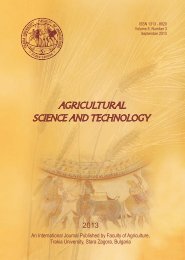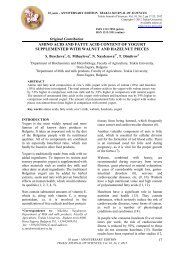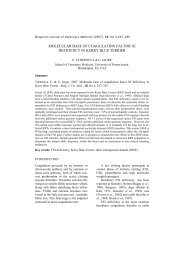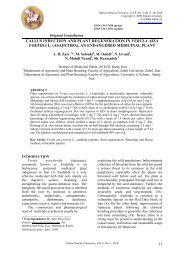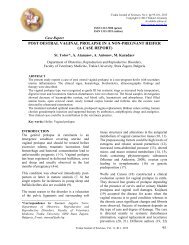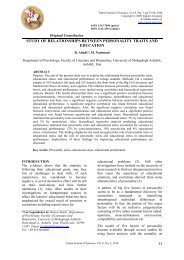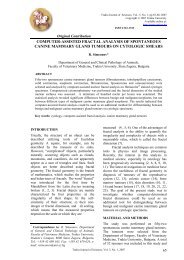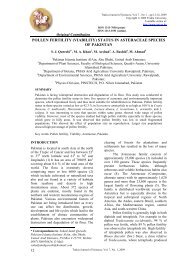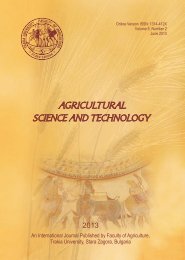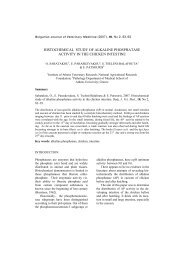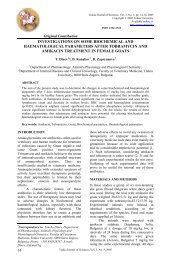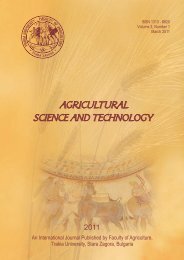Comparative study of different varieties of red clover in Bulgarian ...
Comparative study of different varieties of red clover in Bulgarian ...
Comparative study of different varieties of red clover in Bulgarian ...
Create successful ePaper yourself
Turn your PDF publications into a flip-book with our unique Google optimized e-Paper software.
Instruction for authorsPreparation <strong>of</strong> papersPapers shall be submitted at the editorial<strong>of</strong>fice typed on standard typ<strong>in</strong>g pages (A4,30 l<strong>in</strong>es per page, 62 characters per l<strong>in</strong>e).The editors recommend up to 15 pages forfull research paper ( <strong>in</strong>clud<strong>in</strong>g abstractreferences, tables, figures and otherappendices)The manuscript should be structu<strong>red</strong> asfollows: Title, Names <strong>of</strong> authors andaffiliation address, Abstract, List <strong>of</strong>keywords, Introduction, Material andm e t h o d s , R e s u l t s , D i s c u s s i o n ,Conclusion, Acknowledgements (if any),References, Tables, Figures.The title needs to be as concise and<strong>in</strong>formative about the nature <strong>of</strong> research. Itshould be written with small letter /bold, 14/without any abbreviations.Names and affiliation <strong>of</strong> authorsThe names <strong>of</strong> the authors should bepresented from the <strong>in</strong>itials <strong>of</strong> first namesfollowed by the family names. Thecomplete address and name <strong>of</strong> the<strong>in</strong>stitution should be stated next. Theaffiliation <strong>of</strong> authors are designated by<strong>different</strong> signs. For the author who is go<strong>in</strong>gto be correspond<strong>in</strong>g by the editorial boardand readers, an E-mail address andtelephone number should be presented asfootnote on the first page. Correspond<strong>in</strong>gauthor is <strong>in</strong>dicated with *.Abstract should be not more than 350words. It should be clearly stated what newf<strong>in</strong>d<strong>in</strong>gs have been made <strong>in</strong> the course <strong>of</strong>research. Abbreviations and references toauthors are <strong>in</strong>admissible <strong>in</strong> the summary. Itshould be understandable without hav<strong>in</strong>gread the paper and should be <strong>in</strong> oneparagraph.Keywords: Up to maximum <strong>of</strong> 5 keywordsshould be selected not repeat<strong>in</strong>g the titlebut giv<strong>in</strong>g the essence <strong>of</strong> <strong>study</strong>.The <strong>in</strong>troduction must answer thefollow<strong>in</strong>g questions: What is known andwhat is new on the studied issue? Whatnecessitated the research problem,described <strong>in</strong> the paper? What is yourhypothesis and goal ?Material and methods: The objects <strong>of</strong>research, organization <strong>of</strong> experiments,chemical analyses, statistical and othermethods and conditions applied for theexperiments should be described <strong>in</strong> detail.A criterion <strong>of</strong> sufficient <strong>in</strong>formation is to bepossible for others to repeat theexperiment <strong>in</strong> order to verify results.Results are presented <strong>in</strong> understandabletables and figures, accompanied by thestatistical parameters needed for theevaluation. Data from tables and figuresshould not be repeated <strong>in</strong> the text.Tables should be as simple and as few aspossible. Each table should have its ownexplanatory title and to be typed on aseparate page. They should be outside thema<strong>in</strong> body <strong>of</strong> the text and an <strong>in</strong>dicationshould be given where it should be<strong>in</strong>serted.Figures should be sharp with goodcontrast and rendition. Graphic materialsshould be prefer<strong>red</strong>. Photographs to beappropriate for pr<strong>in</strong>t<strong>in</strong>g. Illustrations aresupplied <strong>in</strong> colour as an exception afterspecial agreement with the editorial boardand possible payment <strong>of</strong> extra costs. Thefigures are to be each <strong>in</strong> a s<strong>in</strong>gle file andtheir location should be given with<strong>in</strong> thetext.Discussion: The objective <strong>of</strong> this sectionis to <strong>in</strong>dicate the scientific significance <strong>of</strong>the <strong>study</strong>. By compar<strong>in</strong>g the results andconclusions <strong>of</strong> other scientists thecontribution <strong>of</strong> the <strong>study</strong> for expand<strong>in</strong>g ormodify<strong>in</strong>g exist<strong>in</strong>g knowledge is po<strong>in</strong>tedout clearly and conv<strong>in</strong>c<strong>in</strong>gly to the reader.Conclusion: The most important consequencesfor the science and practiceresult<strong>in</strong>g from the conducted researchshould be summarized <strong>in</strong> a few sentences.The conclusions shouldn't be numbe<strong>red</strong>and no new paragraphs be used.Contributions are the core <strong>of</strong> conclusions.References:In the text, references should be cited asfollows: s<strong>in</strong>gle author: Sandberg (2002);two authors: Andersson and Georges(2004); more than two authors: Anderssonet al.(2003). When several references arecited simultaneously, they should beranked by chronological order e.g.:(Sandberg, 2002; Andersson et al., 2003;Andersson and Georges, 2004).References are arranged alphabetically bythe name <strong>of</strong> the first author. If an author iscited more than once, first his <strong>in</strong>dividualpublications are given ranked by year, thencome publications with one co-author, twoco-authors, etc. The names <strong>of</strong> authors,article and journal titles <strong>in</strong> the Cyrillic oralphabet <strong>different</strong> from Lat<strong>in</strong>, should betransliterated <strong>in</strong>to Lat<strong>in</strong> and article titlesshould be translated <strong>in</strong>to English.The orig<strong>in</strong>al language <strong>of</strong> articles and bookstranslated <strong>in</strong>to English is <strong>in</strong>dicated <strong>in</strong>parenthesis after the bibliographicreference (<strong>Bulgarian</strong> = Bg, Russian = Ru,Serbian = Sr, if <strong>in</strong> the Cyrillic, Mongolian =Мо, Greek = Gr, Georgian = Geor.,Japanese = Jа, Ch<strong>in</strong>ese = Ch, Arabic = Аr,etc.)The follow<strong>in</strong>g order <strong>in</strong> the reference list isrecommended:Journal articles: Author(s) surname and<strong>in</strong>itials, year. Title. Full title <strong>of</strong> the journal,volume, pages. Example:Simm G, Lewis RM, Grundy B andD<strong>in</strong>gwall WS, 2002. Responses toselection for lean growth <strong>in</strong> sheep. AnimalScience, 74, 39-50Books: Author(s) surname and <strong>in</strong>itials,year. Title. Edition, name <strong>of</strong> publisher,place <strong>of</strong> publication. Example:Oldenbroek JK, 1999. Genebanks andthe conservation <strong>of</strong> farm animal geneticresources, Second edition. DLO Institutefor Animal Science and Health,Netherlands.Book chapter or conference proceed<strong>in</strong>gs:Author(s) surname and <strong>in</strong>itials, year. Title.In: Title <strong>of</strong> the book or <strong>of</strong> the proceed<strong>in</strong>gsfollowed by the editor(s), volume, pages.Name <strong>of</strong> publisher, place <strong>of</strong> publication.Example:Mauff G, Pulverer G, Operkuch W,Hummel K and Hidden C, 1995. C3-variants and diverse phenotypes <strong>of</strong>unconverted and converted C3. In:Provides <strong>of</strong> the Biological Fluids (ed. H.Peters), vol. 22, 143-165, PergamonPress. Oxford, UK.Todorov N and Mitev J, 1995. Effect <strong>of</strong>level <strong>of</strong> feed<strong>in</strong>g dur<strong>in</strong>g dry period, and bodycondition score on reproductivet hperformance <strong>in</strong> dairy cows, IXInternational Conference on ProductionDiseases <strong>in</strong> Farm Animals, Sept.11 – 14,Berl<strong>in</strong>, Germany, p. 302 (Abstr.).Thesis:Penkov D, 2008. Estimation <strong>of</strong> metabolicenergy and true digestibility <strong>of</strong> am<strong>in</strong>o acids<strong>of</strong> some feeds <strong>in</strong> experiments with muscusduck (Car<strong>in</strong>a moshata, L). Thesis for DSc.Agrarian University, Plovdiv, 314 pp.The Editorial Board <strong>of</strong> the Journal is notresponsible for <strong>in</strong>correct quotes <strong>of</strong>reference sources and the relevantviolations <strong>of</strong> copyrights.



